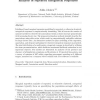Free Online Productivity Tools
i2Speak
i2Symbol
i2OCR
iTex2Img
iWeb2Print
iWeb2Shot
i2Type
iPdf2Split
iPdf2Merge
i2Bopomofo
i2Arabic
i2Style
i2Image
i2PDF
iLatex2Rtf
Sci2ools
89
Voted
CSDA
2006
2006
Fast estimation algorithm for likelihood-based analysis of repeated categorical responses
Likelihood-based marginal regression modelling for repeated, or otherwise clustered, categorical responses is computationally demanding. This is because the number of measures needed to describe the associations within a cluster increase geometrically with increasing cluster size. The proposed estimation methods typically describe the associations using odds ratios, which result in computationally unfeasible solutions for large cluster sizes. An alternative method for joint modelling of the regression, association, and dropout mechanism for clustered categorical responses is presented. The joint distribution of a multivariate categorical response is described by utilizing the mean parameterization, which facilitates maximum likelihood estimation in two important respects. The models are illustrated by analyses of the presence and abscence of schizophrenia symptoms on 86 patients at 12 repeated time-points, and a survey of opinions of 607 adults regarding government spending on 9 diffe...
| Added | 11 Dec 2010 |
| Updated | 11 Dec 2010 |
| Type | Journal |
| Year | 2006 |
| Where | CSDA |
| Authors | Jukka Jokinen |
Comments (0)

